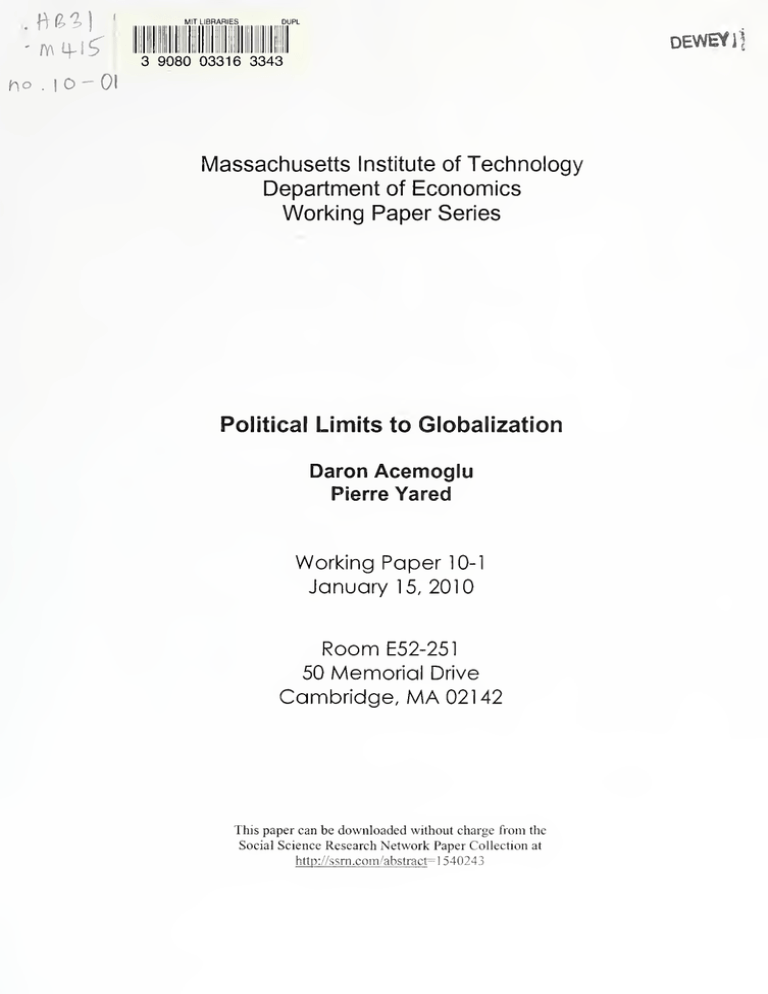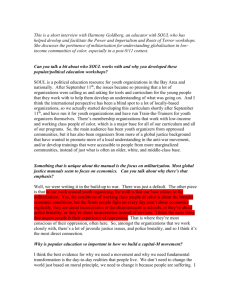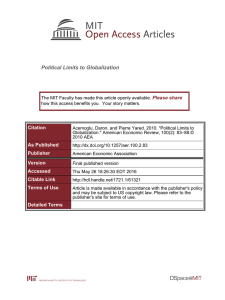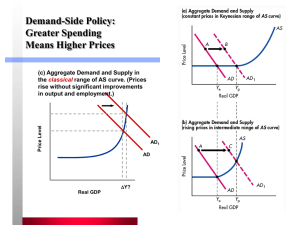MA O' Acemoglu RoomE52-251
advertisement

MIT LIBRARIES DEWEfi 3 9080 03316 3343 ho . I O' 01 Massachusetts Institute of Technology Department of Economics Working Paper Series Political Limits to Globalization Daron Acemoglu Pierre Yared Working Paper 10-1 January 15, 2010 RoomE52-251 50 Memorial Drive Cambridge, MA 02142 This paper can be downloaded without charge from the Social Science Research Network Paper Collection http://ssm.com/abstract "=l 540243 at Political Limits to Globalization* Daron Acemoglu MIT Pierre Yared and CIFAR January Columbia 15, 2010 Abstract Despite the major advances in information technology that have shaped the recent wave of globahzation, openness to trade can change with shifts particular threat may be in militarist sentiments that size of the military, a political choice, and trade policy domestic political equilibria. and a limiting factor around the globe today. is still We to globalization This paper suggests that a and appear to be on the its rise future developments among many nations proxy militarism by spending on the military and the and document that over the past 20 years, countries experiencing greater increases in militarism according to these measures have had lower growth in trade. Focusing on bilateral trade flows, we also show that controlling flexibly country trends, a pair of countries jointly experiencing greater increases for in militarism has lower growth in bilateral trade. Keywords: JEL globalization, trade, military spending, militarism, nationalism Classification: FOl, FIO, F52 for Advanced ReColumbia University, pyared3columbia.edu. We would like to thank Philippe Aghion. Alex Debs, Philippe Martin. Thierry Mayer, Kevin O'Rourke and Mathias Thoenig for suggestions and Dmitriy Sergeyev for excellent research assistance. 'Acemoglu: Massachusetts Institute of Technology and Canadian Institute search, daronQmit.edu; Yared: Digitized by the Internet Archive in 2011 with funding from Boston Library Consortium IVIember Libraries http://www.archive.org/details/politicallimitstOOacem Introduction 1 We live in an unprecedented age of globalization, where technology, of production and goods are increasingly mobile across national boundaries. current wave of globalization major is Nevertheless, globalization to international trade, finance make, and despite the The distinguished from previous ones in part because of the role of information technology. Openness ideas, factors and technology is a choice that countries facilitating role of information technology, many leading players in the world Brazil and Russia, could decide economy including the United to close their borders. A not irreversible. is many countries, even States, China, India, major cause of the end of the previous (also historically unprecedented) 19th century wave of globalization was disillusionment with the international economic order, in large part precipitated by the Great Depression (e.g., though not necessarily and international Glick and Alan Harold James, 2001). Another, somewhat less important cause Avas the conflict (e.g., M. rise of less emphasized nationalism, militarism Ronald Findlay and Kevin H. O'Rourke, 2007, Reuven The previous wave Taylor, 2006).^ of globalization took place in the context of the 100 years following the end of Napoleonic wars, which were vmusually peaceful for European powers; conflict that human In this paper, society it came had experienced we emphasize until then. World War I. that globalization, which depends on political deci- sions of nation states, has political limits, tionalism and militarism. an end following the most widespread to and that these limits are related to na- Despite the increasing reach of globalization, anecdotal evidence suggests that nationalism and militarism are strong around the world, in countries ranging from the United States to China, Russia and India Kagan, 2008). To go beyond anecdotal evidence, ^Militarism is in this Robert paper we proxy nationalist defined as the doctrine or policy of "'aggressive military preparedness," which typically leads to a country maintaining a strong military capability to defend or interests. (e.g., promote its national and by military spending.'^ In addition to being a useful proxy, militarist sentiments military spending might itself impact trade, for example, because tensions or leads to skirmishes between countries. Figure 1 shows the evolution of world trade and total military spending between 1988 and 2007. trade over the past two decades, during which rise of ditures and the size of military known, the increase trends, e.g., Findlay declining for a in the It depicts the steady we have data on military expen- personnel across a large number of countries (as volume of trade during and O'Rourke, 2007). number contributes to it also It this time period reflects is well longer-term shows that military spending, after of years, started increasing from the mid-1990s onwards. This pattern indeed indicates that there might be more than anecdotal evidence pointing to a strengthening in nationalist sentiments Our main contribution in this paper is and miUtarism. to show that military spending, interpretation as a proxy for nationalist sentiment and militarism, sociated with trade. We present two types of evidence. First, is we show in our negatively asthat between 1985 and 2005, countries that experience a greater increase in military expenditure or the size of the military show a relative decline in the volume of trade (compared to other countries in the sample). Moreover, countries whose trading partners ("neighbors" show greater ) show a increases in military expenditure or the size of the military also similar decline. in different These patterns are robust across different specifications and subsamples. Second, we investigate bilateral trade patterns again between 1985 and 2005. The data suggest that trade between two countries grows less when both become more of findings, this pattern In is militarized. While not as robust as the first set rapidly generally present in a variety of different specifications. summary, the data point to a negative correlation between militarization and ^This is true almost by definition of militarism. Tom W. Smith and Lawrence Jarkko (2001) provide several measures of "national pride" constructed from survey evidence, some of which are strongly correlated with military spending across countries. trade. Although we cannot ascertain a causal relationship, the evidence is broadly consistent with an association between the strength of nationalist sentiments and militarism, as proxied by military expenditures or the size of the military, and Overall, this evidence suggests that there might be political ternational trade. in- and military limits to, and dangers against, globalization. Our paper is related to three separate literatures. First, several studies in economic history have investigated the causes of the end of the 19th century globalization James, 2001, Barry Eichengreen and Douglas A. Irwin, 2009). large and growing based on ideas war literature in international relations first less likely (see, articulated by Montesquieu Second, there on the so-called (e.g., is a "liberal theory," and Kant, that greater trade makes example, John R. Oneal and Bruce Russett, 1999, Simon for Polachek, 1980). Several papers in this literature have simultaneously estimated the effect of trade on war and of war disruptions on trade Mayer and Mathias Thoenig, 2008, find a negative effect of militarization this we focus on by showing that the in military conflict are to war on is or who document is from effect survives worth noting, however, that the this disruption effect, when excluded from the Anna Maria Mayda and Dani Rodrik (2001), Philippe Martin, Thierry Havard Herge, Oneal and Russett, 2009), and trade. It distinct (e.g., all data."^ effect of and we demonstrate countries or country pairs engaged Finally, our paper is also related (2002) and O'Rourke and Richard Sinnott a negative relationship between attitudes towards trade and nationalist sentiment in survey responses. may nonetheless capture the fact that greater military spending by a country and neighbors increases the likelihood of military conflict in the future, the anticipation of which discourages trade. We view this as part of the impact of militarism on trade in which we are ''Our results its interested. Data 2 Our measure of trade (opeuness) is a country's trade share of We from Summers-Heston dataset, 2009. GDP in constant prices GDP use this same dataset to measure real per capita and total population.'* Bilateral trade data are from the International 2009 (DoT) Statistics, s, CD-ROM. Let A'^^ denote bilateral between meaning the sum of exports from calculate Xijs for j to i country pairs to j i and exports from in year s for j to both are i to j or available, available. Using GIF (cost, insurance, we take the this j as a fraction of and freight) i and FOB (free i's total trade and we multiply j as a fraction of z's imports by j from this measure by FIRST GDP) Database.^ is We i's is i trade share bilateral trade multiply this fraction by total GDP per capita and population from the Summers-Heston dataset to create a size measures total military personnel and a mecisure of the militarization of "neighbors". inverse distance in kilometers between i's capital and GDP data are missing for Russia for size data, Specifically, let and j's capital.^ a weighted average of the log military spending of country ^ When from the Stockholm International from FIRST.'' Using the mihtary spending and military ''Trade i. GDP. measure of military spending. Military also on board) measure, we construct a measure of bilateral trade between Peace Research Institute GDP We and from to j i s. and otherwise we use whichever measure average, Military spending (as a fraction of using j in year in year i from the Summers-Heston dataset so as to achieve a measure of the between and i which both flows from are available. These flows can be measured using either exports from and all Monetary Fund Direction of Trade i's is we construct tOij represent the We then calculate neighbors using the 1988 so we use the 1989 value. Facts on International Relations and Security Trends Database, http://first.sipri.org/ '^Mihtary spending in 1988 from 1989 is missing for China and for Ru.ssia, so we use the mihtary spending both observations. '^Distance between capital cities for is from Kristian S. Gleditsch and Michael D. Ward (2001). ujij^s as the (relative) weight of country j (7^ method in this calculation. i) We use the same to calculate the weighted average of the log military size of neighbors. This measure captures both the militarization of neighboring countries which would pose the greatest military threat to country with which country i i and also the militarization of those countries should trade most heavily according to the standard gravity models. For the regressions using mihtary spending, the beginning date of the sample 1988 and the end date is date of the sample 1985 and the end date is 2005. For the regressions using military size, the beginning maximize the number of countries Finally, as a robustness check in our is 2003. These dates are chosen to sample given data we exclude availability. countries (or country-pairs) in which a country (at least one of the countries in the pair) experiences a war between 1985 and 2005. For Institute this exercise, we civil or international use the International Peace Research and Uppsala Conflict Data Program Armed Conflict Dataset,^ and we code a country as experiencing a war is intensity, primary party civil war if it and we code a country in an interstate armed experiences an intrastate armed conflict of as experiencing an international war if it is a conflict of wai^ intensity. Cross-Country Evidence 3 We start tarization with cross-country evidence and investigate the relationship between mili- and trade using the following long-difference regression model: Ay, (1) ^ Armed Conflict Dataset. = aAm, + Ax'/3-f-it,. http://www.prio.no/CSCW/Datasets/Armed-Conflict/UCDP-PRIO/ Here Ay, is the change in the trade share of and the end dates of the sample; spending or log mihtary Am; is size) of either GDP of country OECD differential trends in some between the beginning the change mihtarization country or of country i represents the change in a vector of covariates (log and i GDP specifications); i's is log military neighbors; Ax^ per capita, log population, and u, an error term. is medium-run trends focus on long-difference specifications to capture annual fluctuations. Naturally, this specification (i.e., We as opposed to algebraically equivalent to a panel data regression with two observations per country and a of country and year full set fixed effects.^ Table reports estimates of equation 1 sured as (log) military spending, while in Panel Throughout we report standard In Panel A, militarization (1). B militarization is is mea- (log) military size. errors that are robust against arbitrary heteroskedas- ticity. Column 6.3). 1 in Panel decades, holding 2, reports an estimate of This coefficient, which an economically large GDP A effect: all else a of -17.6 with standard error (s.e.= statistically significant at less is than 1%, also implies a 10 percent increase in military spending over two constant, is associated with a reduction in trade share to of approximately 1.8 percent. ^'^ This result which displays a residual plot of trade share is illustrated graphically in Figure vs. military spending and shows a strong negative relationship. Columns countries, 'The 2-4 explore the robustness of this pattern. In many results are similar full set equivalent of a 2, if the level equation corresponding to (1) is estimated on annual data of country common "time effect" in a panel regression). The log military spending of .16 over is captured by the constant (the regression whether a country's variation around the global trend towards greater trade militarization. we exclude Asian of which have experienced an increase in militarization simultane- and year fixed effects. ^"The median country in the sample experienced an increase in the sample period. The increase in trade during the same period with a column is is therefore exploiting due to variation in ously with rapid increases in international trade, which related to the increasing abihty of Asia. The estimate of « may have had other causes, Western companies to outsource and offshore to increases to -22.6 (s.e.= 7.1), confirming that the relationship between militarization and trade is stronger without Asian countries. Column 3 in- vestigates whether our results capture the impact of trade disruption caused by wars; it excludes countries engaged in civil wars or in international wars. Interestingly, our results are stronger once these countries are excluded (coefficient -24.5, s.e.= 9.3). This bolsters our belief that our results are related to the relationship between trade and militarism. column Finally, 4 includes a differential trend in trade for this dummy in trade, this which colunm almost identical to that Columns OECD countries, allowing group of countries. Even though appear to experience faster growth is for in 1. 5-8 are analogous to cohunns 1-4, but use the log military spending coefficient estimate of column neighbors 1, is is -33.0 (s.e.= 14.3). militarization of column 5, the almost twice that Columns 6-8 show robust to the same set of specification checks as in columns 2-4. is 9 includes both log militarization of a country neighbors. its column 1 and The to those in Panel A, with a larger effects effect of own is is still and the weighted military expenditure statistically significant at less In Panel B, militarization and is In increases in militarization by geographically proximate tliat neighbors' military expenditure rization This estimate associated with even a larger relative decline in trade. column to that in a suggesting that this pattern Finally, countries has no effect on our estimate of a, of neighbors, as defined in the previous section, in place of m,. in OECD is log very similar than 1%, while the effect of large but no longer statistically significant. measured as log military size. somewhat smaller quantitative The effects results are similar from own milita- from militarization of neighbors. Overall, the cross-country evidence shows a relatively robust association between changes in military expenditure or size of military personnel and changes tional trade between 1985 and 2005. in interna- , Evidence from Bilateral Trade 4 We next investigate more disaggregated bilateral trade flows data. This allows us to control not only for global trends but also for differences between country pairs, so that we can directly look at trading partner that whether a country becoming more is will reduce More militarized. its trade with a (potential) specifically, we estimate the following gravity-type equation: Ay,j (2) = aAm,mj + where Ay,j now represents the change country i's GDP; Am^mj is partner country fixed i in the trade + 7]^ + u,j, with country j as a fraction of the change in the interaction of and the vector Ax,j includes change population of countries Ax',jp+7]^ and effects; j; ?/f and in the interaction of log and i(,j is 7/^ represent a and i GDP full set the error term which of is j's militarization; per capita and log home and trading allowed to have an arbitrary pattern of heteroskedasticity with clustering at the country-pair level. Analogously to equation moves all eral trade all focuses on long differences and re- country-pair specific characteristics that might simultaneously affect bilat- and militarization of either country. In addition, the specification removes country specific trends (which are the focus of Table of home country and is a which measures its (1), this specification trading partner. Table trading partner country dummies. 1) by including a The full set coefficient of interest the effect of a country's militarization interacted with that of The results from the estimation of equation 2. 8 (2) are reported in Columns 1 1-4 use log military shows the interaction and effect of spending as our measure of militarization. Column home and statistically significant at less there is than trading partner's militarization 1% = (a and -0.090 a strong negative association between a joint rise in is s.e.=: 0.029), negative so that the militarization of the country pair and bilateral trade. ^''- Column interaction effect is The Asian countries. 2 excludes results are similar both larger and more precisely estimated. country pairs where at least one country experienced a the results are also stronger than those in column 1}^ two dummy variables, one country being OECD). The Columns one in the for both countries being OECD (the omitted group results are again similar to those in civil or Finally, in the is and stronger; the Column international war; column 4 includes OECD, and The estimates in these one for only neither country being in the column 1.^'^ 5-8 are analogous to columns 1-4, except that militarization as log military size. 3 excludes is measured columns are also negative, though generally imprecisely estimated and insignificant. 5 Concluding Remarks This short paper emphasized that, despite the major advances in information technology encouraging globalization, openness to trade is still a political choice. This suggests that changes in domestic political equilibria might introduce limits to the process of globalization. militarization, "The We illustrated this general point which has seen a recent quantitative magnitudes of revival, tliis effect is large. on country-level and A GDP ^^None of these ratio in 2005 results change if is effect of bilateral trade. (tlie median by about 0.529c. The median 5.75 point value of AniiVij increase in the sample period) reduces bilateral trade relative to bilateral trade to by focusing on the GDP about 0.06%. we instead only exclude countries which are directly fighting against each other. ^'In addition, the estimates one country in the OECD show that country pairs in the have experienced slower growth OECD and country pairs with only than the baseline. in bilateral trade The evidence we presented suggests that countries experiencing greater mihtarization and those witnessing greater mihtarization among have seen relatively smaller increases mented that country their neighbors (trading partners) in trade over the past 20 years. We also docu- pairs experiencing greater joint increases in militarization have seen relative declines in bilateral trade. Our results come with several caveats. First, it is unclear to what extent these empirical patterns reflect causality since trade and militarization simultaneously affect each other and an explanation may themselves be affected by a third factor. Second, for the apparent rise in we do not have nationalism and militarization around the world. 10 References Eichengreen, Barry and Douglas A. Irwin (2009) "The Slide to Protectionism in the Great Depression: Who Succumbed and Why?" Findlay, Ronald and Kevin H. and the World Economy m the NBER Working Paper. O'Rourke (2007) Power and Plenty: Trade, War, Second Millennium, Princeton University Press, Princeton. Glick, Reuven and Alan M. Taylor (2006) and the Economic Impact Gleditsch, Kristian S. of War," NBER "Collateral Damage: Trade Disruption Working Paper. and Michael D. Ward (2001) "Measuring Space: A Minimum-Distance Database and Applications to International Studies," Journal of Peace Research, 38, 739-758. Herge, Havard, John R. Oneal, and Bruce Russett (2009) "Trade Does Promote Peace: The Perils of Simultaneous Estimation of the Reciprocal Effects of Trade on Conflict," forthcoming in Journal of Peace Research. James, Harold (2001) The End of Globalization: Lessons from the Great Depression, Harvard University Press, Cambridge. Kagan, Robert (2008) The Return of History and House, New the End of Dreams, Random York. Oneal, John R. and Bruce Russett (1999) "Assessing the Liberal Peace with Alternative Specifications: Trade Still Reduces Conflict," Journal of Peace Research, 36, 423-442. Martin, Philippe, Thierry Mayer, and Mathias Thoenig (2008) "Make Trade Not War?", Review of Economic Studies, 75, 865-900. Mayda, Anna Maria and Dani Rodrik (2002) "Why Are Some People (and Countries) More Protectionism than Others?" Working Paper. O'Rourke, Kevin H. and Richard Sinnott (2001) "The Determinants of Individual 11 Trade Policy Preferences: International Survey Evidence," Brookings Trade Forum, 157-196. Polachek, Simon (1980) "Conflict and Trade," Journal of Conflict Resolution 24, 57-78 Smith, Tom W. and Lars Jarkko (2001) "National Pride in Cross-National Per" spective," Working Paper. .. 12 Sample IS a balanced pane! 19fi8-2007 for for each year Militar>' spending is the sum which trade share of across countries and assigned to 1988, 1991 military spending for Russia is Figure corresponds to the residual plot of regression GDP and mil nan,' spending is available for all years Trade share of GDP is the average across comitnes is m 1*^96 dollars For reasons of data availability, military spending for Russia and China m 1989 is interpolated, and 1990 openness for Russia in column 1 of panel A of Table 1 See is assigned to 1988 and 1989 See text for data definitions and sources lexl for data definitions and sources 5^ S OS ^ O " -J OS — — On OO Q O O Q OO ::y O '^ — so o r-J ^ rsl rn rsi i/^ a^ o U OS W < — I OS -o OS o^ °^ o 22 on" c ._aj 1 C/5 ^ J Q O (v^ IN y o t^ 'O -Si 5 dD o C2 m OO c^ OO o o o o ^ O D O — X-I ^ — o 5 S ^ 3 w^ (^1 ^ ~ - ^ Q .1* ^ OO v£; ^ 5^ ^ o; r^ ^ o Llj 13" = S 2 5- '~> QD \0 CO Q U < ^ o ^^ J O ^ ? s D C - g; -a e: Q u o Q O UJ -^ u c- 3- G O Q O o O Di O "c^ a^ T3 O o 9 o O — o o ^ — r-i m oo r- O o o -rr OO OO U^- OO OO .— ^ 11 00 op 5 <S fc 5 o I CJ u- -o . ^ -^ " -a tu -g ,5 i^ C a 5 ^ — CO r'l o ^ U < ~ W ;3 s •a < 9 O <^ fc C« _! 't: -a Q fS — O o 9 o O S =0 ON Q o c cu c o J 1 p o ^ 9 p. <s ^ £ -Si -Q GC o Q •5 2 (3 & u t/i -a tU c — "S:s E S- 00 c i2 c != 2^1 ^ -g « C T= UJ < o O o 9 o *" e:^ H c ^ C c DlJ "5 rt c3 X c t: -^ 1^ £ cp f- X E N UJ O C^ 2 Mj O o 1 CO ij:^ Q U w O c/: ;j= p3 2 ~ DO O a -^ 3 DXJ c o = -J u Q u w o iT a





